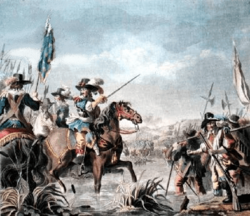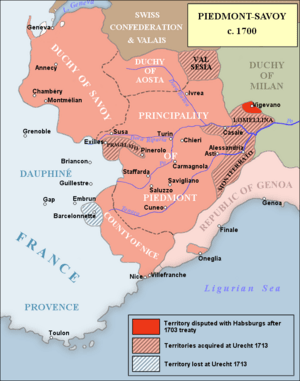Battle of Staffarda facts for kids
Quick facts for kids Battle of Staffarda |
|||||||
|---|---|---|---|---|---|---|---|
| Part of the Nine Years' War | |||||||
 Staffarda by Jean Baptiste Morret |
|||||||
|
|||||||
| Belligerents | |||||||
| Commanders and leaders | |||||||
| Nicolas Catinat | |||||||
| Strength | |||||||
| 12,000 | 18,000 12 guns |
||||||
| Casualties and losses | |||||||
| 1,000 to 2,000 killed or wounded | 2,800 killed or wounded 1,200 captured 11 guns |
||||||
The Battle of Staffarda happened on August 18, 1690. It was part of the Nine Years' War and took place in Piedmont, Northern Italy. This battle was the first big fight in Italy during the war. It happened after Victor Amadeus II of Savoy joined a group called the Grand Alliance. This alliance was against Louis XIV of France.
A French army of about 12,000 soldiers, led by Nicolas Catinat, fought against a Savoyard army. The Savoyard army had 18,000 soldiers and was led by Victor Amadeus and Prince Eugène of Savoy. The French won the battle. This victory allowed Catinat to take over most of Piedmont. However, he could not capture Turin, the capital city. This was because his soldiers were sick, he didn't have enough men, and supplies were hard to get.
Contents
Why the Battle Happened
The Nine Years' War in Italy
By 1690, the Nine Years' War had been going on for three years. Both France and the Allies were mostly fighting in the Spanish Netherlands. They also fought along the Rhine river. Neither side could win a clear victory in these areas. This made Northern Italy an important place. The Allies saw it as a way to "open a door" into France.
Savoy's Important Location
The Savoyard state was made up of different areas. These included the County of Nice and the Duchy of Savoy, which are now in modern France. It also included the Duchy of Aosta and Principality of Piedmont. Louis XIV of France thought of Savoy as a part of France. France controlled two key forts in Piedmont. These were Pinerolo in the west and Casale in the east. France had taken Pinerolo in 1631 and Casale in 1681.
Before the Fight
At the start of 1690, Victor Amadeus had not yet officially joined the war. His army was small, with only 8,000 men. But King Louis XIV of France knew he needed Savoy to stay on his side. Louis XIV ignored Savoy's own interests and made demands on Victor Amadeus.
France wanted Amadeus to send 2,000 foot soldiers and three groups of dragoons to help French forces. This was almost half of his army. Or, he could join his army with Nicolas Catinat's forces to attack the Spanish-controlled Duchy of Milan. France also demanded that Amadeus hand over the fort in Turin and another fort called Verrua. If he refused, a French official said he would "be punished in such a manner that he remembers it for the rest of his life."
These demands were a direct attack on Savoy's independence. This pressure actually made Victor Amadeus want to fight France. In the summer of 1690, he decided to stand up to France. He started to look for help from the Grand Alliance.
Amadeus had his own conditions for joining the Alliance. He wanted his family's claim to the Duchy of Montferrat to be recognized. He also wanted the fort of Casale to be destroyed. Most importantly, he wanted Pinerolo back. He also hoped to take over a French town in Dauphiné. Amadeus quickly prepared for war and asked England and Spain for money. On June 4, he declared war on France.
The Battle Begins
In July, Catinat took charge of the French forces in Piedmont. He had about 12,000 soldiers. Victor Amadeus received 10,000 Spanish soldiers from Milan. He was also promised 5,000 soldiers from the Holy Roman Empire, led by his cousin, Prince Eugene of Savoy. Also, the Vaudois, a Protestant group in Savoy, joined their Duke. They had been treated badly by both Louis XIV and Amadeus before. But now they fought to defend their homes. They fought fiercely against the French.
King Louis XIV wanted to punish Amadeus. He ordered Catinat to burn and tax parts of Savoy and Piedmont. If local farmers tried to fight back, they were hanged. However, a French commander, the Marquis de Feuquieres, suffered a big loss. He was sent with 1,200 troops to Luserna. He was forced to leave the town, losing about 600 men.
While Catinat's army moved across the Piedmont plain, another French general, the Marquis de Saint-Ruth, took most of the Duchy of Savoy. He defeated the Savoyard forces there. Only the strong fort of Montmélian remained in Savoyard hands. Losing Savoy was a big problem for the Grand Alliance. It made it much harder to invade France.
To stop the destruction, Amadeus decided to fight the French. Prince Eugene advised against it, but Amadeus insisted. He thought the French were weak after Feuquieres' loss. Amadeus left his camp at Villafranca to attack Catinat.
Catinat left his camp at Cavour and marched south to take Saluzzo. When Amadeus moved to stop him, they met at the abbey of Staffarda on August 18. The battlefield had marshes and hedges, which made it hard to move. These also protected the Savoyard lines. But the French soldiers eventually broke through. Prince Eugene's leadership of the Savoyard cavalry saved the Allied army from total defeat. Amadeus lost 2,800 soldiers, with 1,200 captured. He also lost 11 of his 12 cannons. Catinat's army lost between 1,000 and 2,000 soldiers.
What Happened Next
After the battle, Catinat took Saluzzo, Savigliano, and Fossano. He demanded supplies and taxes from these areas. Towns that refused to pay, like Ceresole and Autrive, were looted. When the Imperial troops finally arrived in Piedmont, they couldn't do much. Some said it was because the Spanish didn't want to help Victor Amadeus. Spain and Savoy had been rivals for a long time in Northern Italy. Prince Eugene even said the Spanish "want to do absolutely nothing."
Catinat then went to Susa, an important fort that controlled routes to Briançon. He started digging trenches there on November 11. The fort surrendered two days later. But Catinat's plans to take Turin and other areas had to be stopped. This was because of problems with supplies, not enough soldiers, and sickness in his army. The French army couldn't get enough food from the damaged Piedmont. So, they moved to winter camps in Savoy, Dauphiné, and Provence. The Imperial troops stayed in Montferrat, which made its pro-French ruler, the Duke of Mantua, very unhappy.
Sources
- McKay, Derek & Scott, H. M (1984). The Rise of the Great Powers 1648–1815. Longman. ISBN: 0-582-48554-1


